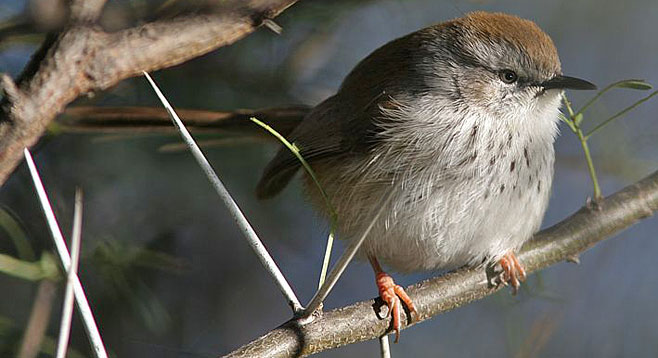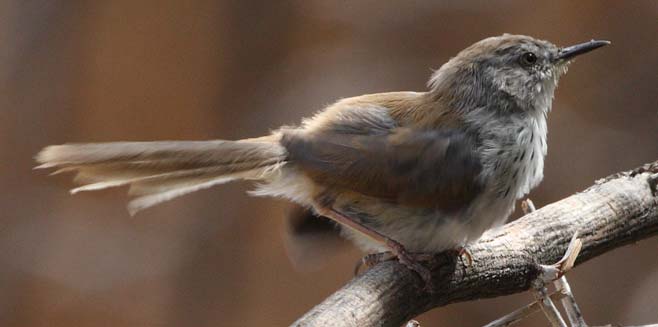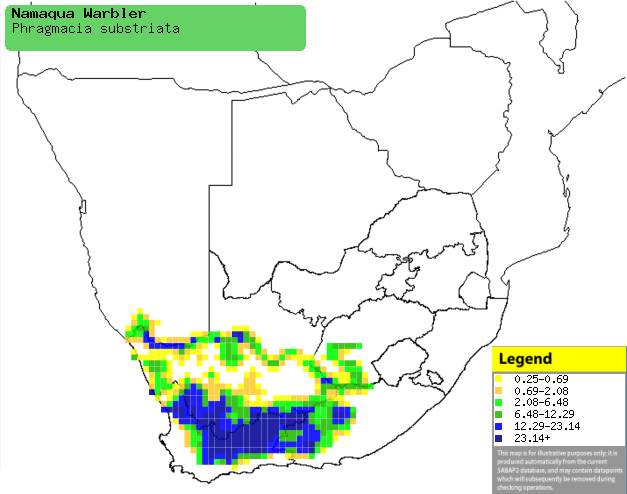|
Phragmacia substriata (Namaqua
warbler)
Namakwalangstertjie [Afrikaans]; Namaqua-prinia [Dutch];
Prinia du Namaqua [French]; Namasänger, Namaprinie [German]; Prínia da Namaqua
[Portuguese]
Life
> Eukaryotes >
Opisthokonta
> Metazoa (animals) >
Bilateria >
Deuterostomia > Chordata >
Craniata > Vertebrata (vertebrates) > Gnathostomata (jawed
vertebrates) > Teleostomi (teleost fish) > Osteichthyes (bony fish) > Class:
Sarcopterygii (lobe-finned
fish) > Stegocephalia (terrestrial
vertebrates) > Tetrapoda
(four-legged vertebrates) > Reptiliomorpha > Amniota >
Reptilia (reptiles) >
Romeriida > Diapsida > Archosauromorpha > Archosauria >
Dinosauria
(dinosaurs) > Saurischia > Theropoda (bipedal predatory dinosaurs) >
Coelurosauria > Maniraptora > Aves
(birds) >
Order: Passeriformes > Family: Cisticolidae
 |
|
Namaqua warbler, Karoo National Park, South Africa. [photo
Trevor Hardaker ©] |
 |
|
Namaqua warbler, Tanqua Karoo National Park, South
Africa. [photo
Duncan Robertson ©]. |
Distribution and habitat
Endemic to South Africa and extreme southern Namibia,
generally preferring Acacia woodland, reedbeds or honey-thorn (Lycium)
thickets adjacent to permanent rivers, streams and drainage lines. It may
also be found in overgrown orchards near irrigation canals or gardens .
|
 |
|
Distribution of Namaqua warbler in southern Africa,
based on statistical smoothing of the records from first SA Bird Atlas
Project (©
Animal Demography unit, University of
Cape Town; smoothing by Birgit Erni and Francesca Little). Colours range
from dark blue (most common) through to yellow (least common).
See here for the latest distribution
from the SABAP2. |
Food
It eats a variety of small invertebrates and fruit,
foraging in tangled undergrowth, floating derbis and occasionally on the ground. The following food items have been recorded
in its diet:
- Invertebrates
- Coleoptera
(beetles)
- weevils
- tortoise beetles (Cassidae)
-
Hymenoptera
- ants
- Anoplolepis
- Monomorium
- Campanotus
- Tetramorium
- wasps
- insect egg cases
-
Hemiptera (bugs)
- Fruit and seeds
- Lycium (honey-thorns)
- Atriplex semibaccata (alien Creeping saltbrush)
Breeding
- The nest is a deep, open cup built of dry grass, shreds of Bulrush (Typha
capensis) leaves and roots, lined with soft feathers, fluffy seeds and
rootlets. It is typically placed in grass tuft, shrub, bulrush or flood
debris on the riverbank, the exterior the nest is often camouflaged with
bark, lichen, twigs and dead leaves.
- Egg-laying season is from August-April.
- It lays 2-4 eggs, which are incubated for about 16 days.
- Little is known about the chicks, other then that they stay in the nest
for roughly 15 days.
Threats
Not threatened.
References
-
Hockey PAR, Dean WRJ and Ryan PG 2005. Roberts
- Birds of southern Africa, VIIth ed. The Trustees of the John Voelcker
Bird Book Fund, Cape Town.
|
